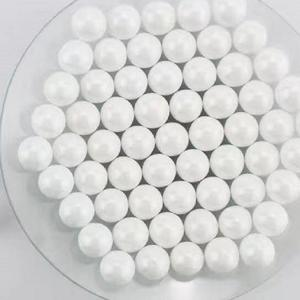Discover Premium Ceramic Products | Durability & Elegance United | Advanced Ceramics
1. Introduction
Just 24 hours ago, leading semiconductor manufacturer GlobalWafers announced a $5 billion expansion of its 300mm silicon wafer facility in Texas—citing ‘unprecedented demand for high-purity crystal substrates’ driven by AI chips and EV power electronics. At the heart of this expansion lies a seemingly humble but mission-critical component: the silicon carbide crucible.

While most consumers associate silicon carbide with abrasives or even kitchenware like silicon carbide ceramic baking dishes, its role in advanced materials processing is far more profound. In particular, silicon carbide crucibles have become indispensable in the controlled growth of semiconductor-grade silicon crystals—a process demanding extreme thermal stability, minimal contamination, and resistance to molten silicon’s corrosive nature.
2. Why Silicon Carbide Crucibles Excel in Crystal Growth
Monocrystalline silicon—the backbone of modern microchips—is typically grown using the Czochralski (CZ) method, where polysilicon is melted at around 1,414°C and a seed crystal is slowly pulled to form a single-crystal ingot. This process places immense demands on the crucible material.
Silicon carbide crucibles meet these demands thanks to their exceptional properties:
- Thermal conductivity up to 120 W/m·K, enabling uniform heat distribution
- Chemical inertness against molten silicon and common dopants
- High mechanical strength even above 1,600°C
- Low thermal expansion, reducing cracking during thermal cycling
These traits make silicon carbide far superior to traditional quartz crucibles, which can introduce oxygen impurities and degrade rapidly under repeated high-temperature cycles.

3. Silicon Carbide vs. Alternatives: Boron Carbide and Silicon Nitride
When evaluating high-temperature ceramics for crucible applications, engineers often compare silicon carbide with boron carbide and silicon nitride. While boron carbide vs silicon carbide debates highlight boron carbide’s higher hardness, it suffers from poor oxidation resistance above 800°C and is significantly more expensive.
Silicon nitride, on the other hand, offers excellent thermal shock resistance and is used in components like silicon nitride rings, silicon nitride plates, and custom silicon nitride heat shields. However, it’s generally not suitable as a primary crucible material for molten silicon due to potential nitridation reactions. That said, silicon nitride crucible factories do produce specialized vessels for lower-temperature alloy processing.
For silicon crystal growth, silicon carbide remains the gold standard—especially in its reaction-bonded (RBSiC) or sintered forms. RBSiC silicon carbide tile blocks and dense silicon carbide ceramic columns are often used to construct support structures within crystal pullers, further enhancing process stability.
4. Beyond the Crucible: Supporting High-Temperature Infrastructure

The silicon carbide ecosystem in semiconductor fabs extends well beyond the crucible itself. Engineers rely on a suite of complementary components made from the same robust material:
- Silicon carbide burner nozzles for precise furnace heating
- Silicon carbide bricks for furnace linings
- Silicon carbide thermocouple protection tubes to monitor melt temperature without contamination
- Silicon carbide ceramic tubes for high-temperature gas delivery
Even silicon carbide discs and silicon carbide ceramic grinding discs are used in post-processing to shape and polish ingots with micron-level precision.
Notably, while consumer products like silicon carbide ceramic dinner plates or silicon carbide ceramic serving bowls showcase the material’s aesthetic and thermal qualities, industrial applications demand far higher purity and structural integrity—often using high-purity silicon carbide sourced from tightly controlled supply chains.
5. Future Outlook and Market Dynamics
With the high purity silicon nitride powder market projected to grow at 8.2% CAGR through 2030, parallel advancements in silicon carbide processing are accelerating. Innovations in additive manufacturing now allow for custom-shaped silicon carbide crucibles with integrated cooling channels or embedded sensors—features that could further improve crystal yield and reduce defects.
Moreover, as the industry pushes toward larger-diameter wafers (450mm and beyond), the demand for larger, more robust silicon carbide crucibles will intensify. This creates opportunities not just for crucible manufacturers but also for producers of ancillary components like silicon carbide ceramic pipe systems and porous silicon carbide ceramic tubes used in vacuum filtration of process gases.
6. Conclusion
From the molten heart of a crystal puller to the polished surface of a finished wafer, silicon carbide crucibles are unsung heroes of the semiconductor revolution. Their unique blend of thermal, chemical, and mechanical properties makes them irreplaceable in producing the ultra-pure silicon that powers everything from smartphones to electric cars. As chipmakers race to scale production, the humble silicon carbide crucible—and its extended family of high-performance ceramics—will remain at the forefront of materials innovation.
Our Website founded on October 17, 2012, is a high-tech enterprise committed to the research and development, production, processing, sales and technical services of ceramic relative materials such as Silicon. Our products includes but not limited to Boron Carbide Ceramic Products, Boron Nitride Ceramic Products, Silicon Carbide Ceramic Products, Silicon Nitride Ceramic Products, Zirconium Dioxide Ceramic Products, etc. If you are interested, please feel free to contact us.
